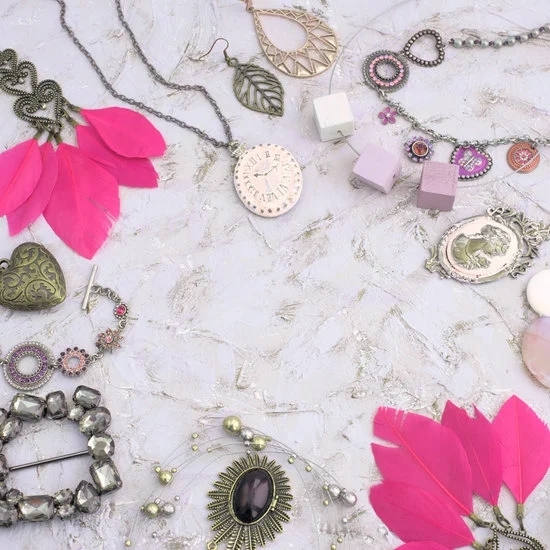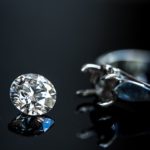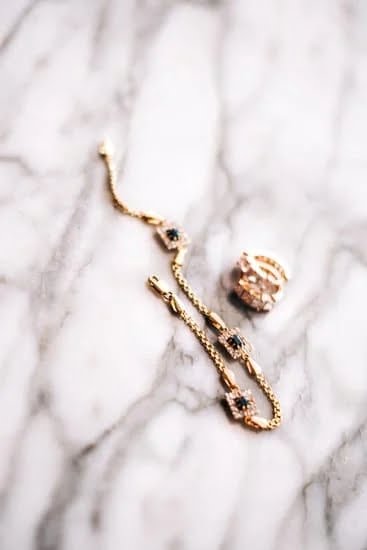Rock crystal jewelry is a stunning and captivating accessory that has been cherished for centuries. It is essential to know how to identify this unique type of jewelry, as it possesses remarkable properties and significance.
In this article, we will delve into the world of rock crystal jewelry, exploring its history, types, physical characteristics, authenticity tests, and expert tips for identification. Whether you are a collector or simply drawn to its beauty, understanding how to differentiate between genuine and synthetic pieces is crucial.
Rock crystal jewelry is defined by its use of transparent quartz crystals. Known for their mesmerizing clarity and luminosity, these crystals have long held symbolism and spiritual importance in various cultures around the world. The term “rock crystal” refers specifically to colorless quartz; however, it can also pertain to clear or slightly hued variations such as smoky quartz or rose quartz.
The translucent nature of rock crystal allows light to pass through it effortlessly, creating a radiant glow when set in jewelry. Its ethereal appearance makes it a popular choice for both timeless classic designs and modern statement pieces. In addition to its aesthetic appeal, rock crystal is believed to possess healing properties such as energy amplification and clarity of thought.
As we venture into the enchanting realm of rock crystal jewelry in this article, we will explore its rich history, various types available in the market today, as well as key physical characteristics that define an authentic piece. By the end of this journey, you will be equipped with the knowledge needed to appreciate and identify the beauty of rock crystal jewelry while being able to differentiate between natural and synthetic variations.
History of Rock Crystal Jewelry
The History of Rock Crystal Jewelry is a fascinating exploration of the ancient origins and enduring popularity of this exquisite gemstone. Rock crystal jewelry has a rich history that stretches back thousands of years, with evidence of its use dating as far back as the Ancient Egyptians and Greeks.
In ancient times, rock crystal was highly valued for its beauty and believed to have mystical properties. It was often used to create talismans and amulets worn for protection and to ward off evil spirits. The Ancient Romans also prized rock crystal, using it to create intricate carved gemstones called cameos.
During the Renaissance period, rock crystal jewelry experienced a resurgence in popularity. It was frequently used for pendants, beads, and cameos, with artisans incorporating detailed engravings into the translucent stone. The Baroque era saw an increase in the use of rock crystal for ornate chandeliers, candelabras, and decorative objects.
Rock crystal jewelry continued to be coveted throughout history, with prominent figures such as Queen Victoria known for their fondness for this gemstone. In more recent times, designers have embraced rock crystal’s versatility by creating innovative pieces that range from delicate necklaces to bold statement rings.
Today, rock crystal jewelry remains highly sought after in both vintage and contemporary designs. Its timeless appeal transcends fashion trends and appeals to those who appreciate its natural elegance. Whether you’re drawn to antique pieces that carry a sense of history or modern creations that showcase the stone’s inherent beauty, there is sure to be a piece of rock crystal jewelry that captures your imagination.
| Key Points | Examples |
|---|---|
| Ancient Egyptians and Greeks valued rock crystal for its beauty | Ancient Egyptian amulets made from rock crystal |
| Ancient Romans used rock crystal to create intricate cameos | Roman rock crystal cameo pendant |
| Renaissance artisans incorporated engravings into rock crystal jewelry | Engraved Renaissance rock crystal pendant |
| Baroque era saw the use of rock crystal for decorative objects | Baroque rock crystal chandelier |
| Prominent figures like Queen Victoria were fans of rock crystal jewelry | Queen Victoria’s rock crystal brooch |
Types of Rock Crystal Jewelry
Rock crystal jewelry comes in various forms, each offering its own unique beauty and style. From necklaces to bracelets and earrings, there are endless options for those who love the enchanting allure of rock crystal. Whether you’re looking for a statement piece or something more delicate and understated, there is a type of rock crystal jewelry that will suit your taste.
One of the most popular types of rock crystal jewelry is necklaces. A rock crystal necklace can be a stunning centerpiece to any outfit, adding an elegant touch. The crystals can be cut into different shapes such as teardrops, ovals, or squares, creating a variety of necklace designs that range from simple and minimalist to intricate and ornate.
Bracelets are another beautiful way to showcase rock crystal jewelry. They can be crafted with single or multiple crystals, and often incorporate other gemstones or metals for added visual interest. Rock crystal bracelets make for versatile accessories that can be worn casually during the day or dressed up for formal occasions.
For those who prefer more subtle adornments, rock crystal earrings are an excellent choice. Whether in the form of studs, dangles, or hoops, these earrings can add a touch of sparkle and elegance to any ensemble. Their versatility makes them suitable for both everyday wear and special occasions.
| Type | Description |
|---|---|
| Necklaces | Can be the centerpiece of an outfit; available in various shapes and designs. |
| Bracelets | Versatile accessories that can be worn casually or dressed up; often incorporate other gemstones. |
| Earrings | Add a touch of sparkle and elegance; available in studs, dangles, or hoops. |
From necklaces to bracelets and earrings, rock crystal jewelry offers a wide range of options for those who appreciate its beauty. The type you choose will depend on your personal style, the occasion, and how you want to showcase the captivating allure of these crystals. Whether it’s a statement necklace, a delicate bracelet, or a pair of stunning earrings, rock crystal jewelry is sure to elevate any ensemble.
Physical Characteristics of Rock Crystal Jewelry
Rock crystal jewelry is known for its unique physical characteristics that set it apart from other gemstones. When identifying rock crystal jewelry, there are key attributes to look for in order to determine its authenticity and quality.
- Clarity: One of the most important features of rock crystal jewelry is its clarity. Genuine rock crystal should have a high level of transparency, allowing light to pass through without any significant obstruction or cloudiness. The clearer the stone, the higher its value and desirability.
- Transparency: In addition to clarity, transparency refers to how well light can travel through the rock crystal. Transparent pieces will allow light to pass through easily, giving them a luminous appearance. On the other hand, semi-transparent or translucent pieces may have some degree of haziness or opacity.
- Color Variations: While rock crystal is primarily colorless and transparent, it can also occur in various shades such as milky white, smoky gray, or even pale pink. These slight color variations can add uniqueness and beauty to the jewelry piece.
To determine if a piece of rock crystal jewelry is genuine, it’s important to note these physical characteristics and examine them closely. However, it’s worth mentioning that certain treatments or enhancements can affect these natural attributes, so consulting with an experienced gemologist or jeweler is advisable when in doubt.
Synthetic vs. Natural Rock Crystal Jewelry
Rock crystal jewelry has long been admired for its beauty and versatility. However, when shopping for rock crystal jewelry, it’s important to understand the difference between synthetic and natural options. This section will delve into the distinctions between the two types of rock crystal jewelry, as well as their respective benefits and drawbacks.
Synthetic rock crystal jewelry, also known as lab-created or man-made, is made in a laboratory using various techniques. These include the hydrothermal process, where a solution of minerals is heated and pressurized to create crystals that mimic natural ones. Another method is called the flux process, which utilizes high temperatures and chemical solutions to grow crystals. Synthetic rock crystal jewelry often has an almost flawless appearance due to controlled conditions during its creation.
One major advantage of synthetic rock crystal jewelry is its affordability. Lab-created pieces tend to be less expensive than their naturally formed counterparts because they can be produced in larger quantities. Additionally, synthetic crystals can have consistent quality and color since they are created under controlled conditions. However, some individuals may prefer natural rock crystal jewelry for its unique properties and connection to nature.
In contrast to synthetic options, natural rock crystal jewelry forms over millions of years in the Earth’s crust. It is sourced from various locations around the world, including Brazil, Madagascar, and the United States. Natural rock crystal often exhibits subtle variations in clarity and color due to factors like impurities or mineral inclusions present during its formation. These imperfections can add character and interest to the piece.
Natural rock crystal jewelry is cherished by many for its organic beauty and metaphysical properties attributed to crystals formed through geological processes. Whether you’re drawn to the mystique of ancient civilizations or simply appreciate nature’s creations, owning a piece of natural rock crystal jewelry can provide a sense of connection with our planet’s history.
When choosing between synthetic and natural rock crystal jewelry, consider your personal preferences as well as your budget. Regardless of which option you select, both types offer their own unique beauty and can be enjoyed as stunning adornments.
Identifying Rock Crystal Jewelry by Hallmarks and Markings
When it comes to identifying the authenticity of rock crystal jewelry, one important aspect to consider is the presence of hallmarks and markings. Hallmarks and markings can provide valuable insights into the origin, age, and quality of the piece. In this section, we will guide readers on how to spot authenticity through these hallmarks and markings on rock crystal jewelry.
Understanding Hallmarks
Hallmarks are stamps or engravings that are typically found on the metal components of the jewelry, such as the clasp or setting. These hallmarks serve as a certification of authenticity and quality. Different countries have their own hallmarking systems, so it’s important to familiarize yourself with the symbols used in your region.
One common hallmark found on rock crystal jewelry is a purity mark for silver pieces. In most countries, silver is marked with a number indicating its purity level, such as “925” for sterling silver (92.5% pure silver). Gold pieces may be stamped with a carat weight symbol such as “14K” or “18K,” indicating the gold content.
Recognizing Special Markings
In addition to hallmarks indicating metal purity, you may also find special markings specific to rock crystal jewelry. These markings can provide information about the origin or designer of the piece.
For example, some antique rock crystal jewelry may bear marks that indicate it was made during a particular time period or by a renowned artisan. Researching these marks can help you identify valuable vintage pieces.
Another marking to look out for is a brand mark. Many contemporary jewelers have their own brand marks or logos that they stamp onto their creations. This can be an excellent indication of high-quality craftsmanship and design.
It’s worth noting that not all rock crystal jewelry will have hallmarks or special markings. Some pieces may be unmarked due to their age or style. However, when present, these hallmarks and markings can provide important clues about the authenticity and quality of the piece.
Testing the Authenticity of Rock Crystal Jewelry
When purchasing or evaluating rock crystal jewelry, it is important to be able to determine its authenticity. There are several methods and tools that can be used to test whether a piece of rock crystal jewelry is genuine or not.
- Scratch Test: One common method to determine the authenticity of rock crystal jewelry is by conducting a scratch test. Rock crystal is relatively hard with a Mohs hardness rating of 7, so it should not easily get scratched by materials with lower ratings. Using a known material such as quartz or glass, gently scrape the surface of the jewelry. If there are visible scratches, it may indicate that the piece is made from a different material.
- Temperature Test: Another way to identify authentic rock crystal jewelry is through the temperature test. Place the piece in your hand and observe how quickly it warms up or cools down.
Genuine rock crystal has good thermal conductivity, which means that it will rapidly adjust to your body temperature. If there is a delay in temperature change or if it feels unnaturally cold or warm, it may suggest that the piece is not made of true rock crystal. - Reflection Test: The reflection test can help determine if rock crystal jewelry is genuine or synthetic. Hold the piece up to light and observe how light interacts with it. In natural rock crystal, light should pass through clearly without any distortions or rainbow-like reflections. If you notice any hazy areas, internal fractures, or spectral colors within the stone, it may indicate that it is synthetic rather than natural.
It’s important to note that these tests are not foolproof and may require some expertise in gemology to accurately interpret the results. If you’re unsure about testing on your own, consulting an experienced gemologist or jeweler can provide more reliable insight into determining the authenticity of your rock crystal jewelry.
By being able to confidently test the authenticity of rock crystal jewelry, you can ensure that you are investing in genuine pieces and avoid purchasing counterfeit or synthetic imitations.
Expert Tips for Identifying Rock Crystal Jewelry
Rock crystal jewelry is a beautiful and timeless accessory that has been cherished for centuries. With so many options available, it can sometimes be difficult to determine the authenticity and quality of rock crystal pieces. In this section, we will provide expert tips for identifying genuine rock crystal jewelry.
Seek Advice from Experienced Gemologists
When in doubt, it’s always a good idea to consult with an experienced gemologist or jeweler. These professionals have extensive knowledge and expertise in identifying different types of gemstones, including rock crystal. They can provide valuable insights and guidance on how to distinguish genuine rock crystal from imitations or other similar gemstones. A certified gemologist can also assist in evaluating the overall quality of a piece, such as its cut and clarity.
Examine the Clarity and Transparency
One of the key physical characteristics to look for when identifying rock crystal jewelry is its clarity and transparency. Genuine rock crystal should be completely transparent with little to no visible internal flaws or inclusions. Hold the jewelry up to light and examine it closely. If you notice any cloudiness, internal cracks, or impurities, it may indicate that the piece is not made of real rock crystal.
Look for Natural Color Variations
While rock crystal is generally colorless, there can be subtle variations in hue due to impurities present during its formation process. These natural color variations are what make each piece unique.
Genuine rock crystal may exhibit a slight yellowish, grayish, or smoky tint, but should not display intense colors like those found in other gemstones. Be cautious if you come across a piece of “rock crystal” that appears to have vibrant hues such as blue or pink, as this could be an indication that it is actually a synthetic material.
Consider Weight and Temperature
Authentic rock crystal typically has a cool touch and feels heavier compared to synthetic materials like glass or plastic. When holding a piece of rock crystal jewelry, pay attention to its weight and temperature. If it feels lightweight or warm to the touch, it may be an indication that it is not genuine rock crystal.
By following these expert tips, you can enhance your ability to identify genuine rock crystal jewelry. Whether you’re shopping for yourself or looking to add a stunning piece to your collection, understanding how to authenticate rock crystal will ensure that you are investing in a high-quality and beautiful gemstone.
Care and Maintenance of Rock Crystal Jewelry
Rock crystal jewelry is not only beautiful but also valuable, making it crucial to properly care for and maintain these pieces. By following the right care routine, you can ensure that your rock crystal jewelry stays in pristine condition for years to come. In this section, we will provide you with expert advice on caring for and maintaining your rock crystal jewelry.
To begin, it is important to handle your rock crystal jewelry with care. Avoid exposing it to harsh chemicals such as cleaning agents or perfumes that can dull its luster or damage the stone. When not wearing your jewelry, store it in a fabric-lined box or pouch to protect it from scratches and other physical damage that can occur from contact with other pieces of jewelry.
When cleaning your rock crystal jewelry, it is best to use mild soap and warm water. Gently scrub the piece with a soft brush or cloth, paying particular attention to any areas where dirt or oil may have accumulated. Rinse thoroughly and pat dry with a clean cloth. Avoid using ultrasonic cleaners or steamers as they can cause heat damage to the stone.
It is also recommended to periodically have your rock crystal jewelry professionally cleaned and inspected by a jeweler. They will have the expertise and specialized equipment needed to ensure that your piece is properly cared for. Additionally, they can check for any loose stones or signs of wear that may need repair.
By following these care tips and regularly maintaining your rock crystal jewelry, you can ensure that it remains a cherished piece for generations to come. Taking the time to care for these beautiful pieces will allow you to continue enjoying their beauty and significance in your life.
Conclusion
In conclusion, rock crystal jewelry is a fascinating and beautiful form of adornment that has been cherished for centuries. Its ancient origins and popularity among different cultures and time periods highlight its enduring appeal. With various types, designs, and styles available, there is something to suit every taste.
When identifying rock crystal jewelry, it is important to consider its physical characteristics such as clarity, transparency, and color variations. These attributes can provide valuable insights into the authenticity and quality of the piece. Understanding the differences between synthetic and natural rock crystal jewelry is also crucial in making an informed purchase.
Hallmarks and markings on rock crystal jewelry can further assist in determining authenticity. Paying attention to these details can help ensure that you are investing in a genuine piece of rock crystal jewelry. There are also several testing methods available, such as scratch tests or temperature tests, which can add another layer of certainty when assessing a piece’s authenticity.
Lastly, caring for your rock crystal jewelry is essential in maintaining its beauty and longevity. Proper cleaning methods, storage tips, and precautions against damage should be followed to ensure that your pieces remain stunning for years to come.
In embracing the world of rock crystal jewelry, one can appreciate not only its aesthetic value but also the rich history and significance behind each piece. Whether you are a collector or simply someone who appreciates unique and exquisite accessories, exploring the world of rock crystal jewelry is bound to be an enjoyable journey. So go ahead and indulge yourself in this captivating realm of beauty.

Welcome to my jewelry blog! My name is Sarah and I am the owner of this blog.
I love making jewelry and sharing my creations with others.
So whether you’re someone who loves wearing jewelry yourself or simply enjoys learning about it, be sure to check out my blog for insightful posts on everything related to this exciting topic!





